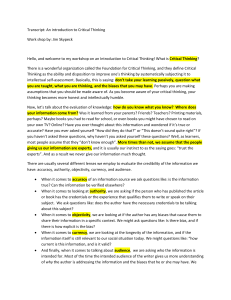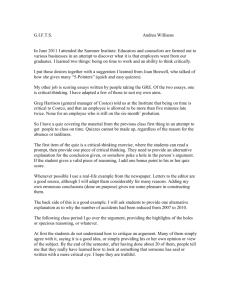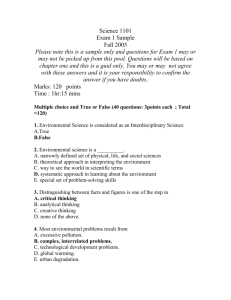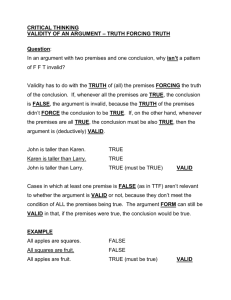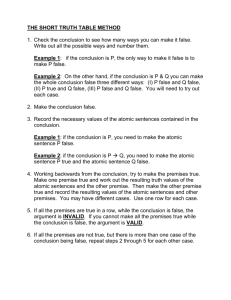Reasoning: – Facts, Inferences, Judgments – Premises & Conclusion
advertisement
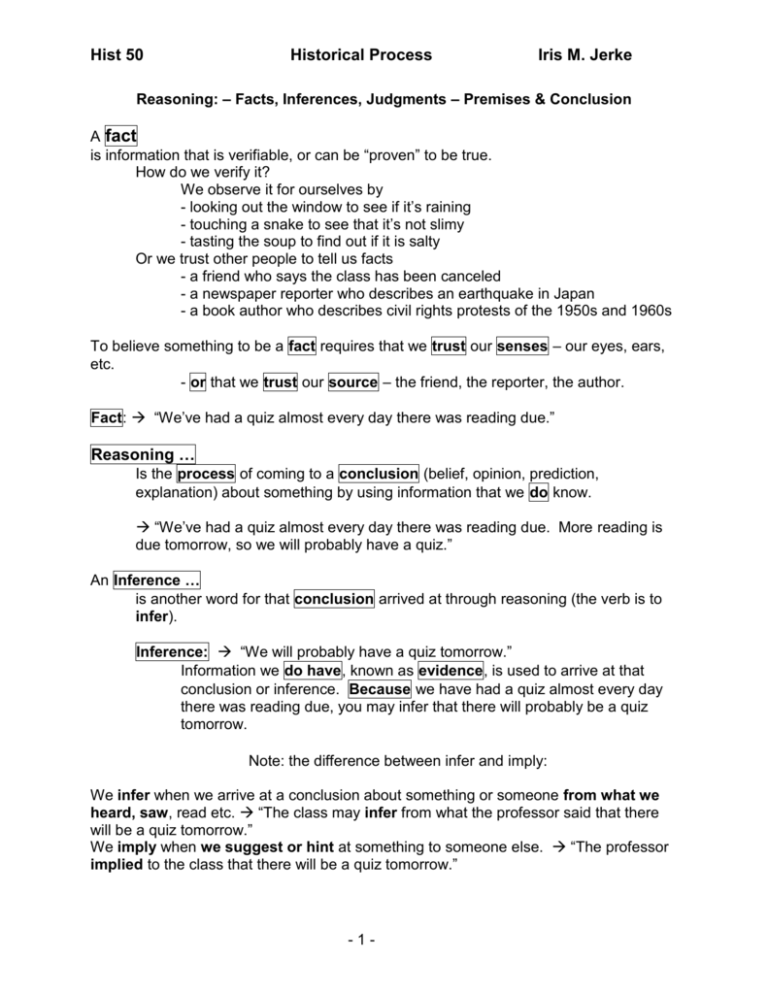
Hist 50 Historical Process Iris M. Jerke Reasoning: – Facts, Inferences, Judgments – Premises & Conclusion A fact is information that is verifiable, or can be “proven” to be true. How do we verify it? We observe it for ourselves by - looking out the window to see if it’s raining - touching a snake to see that it’s not slimy - tasting the soup to find out if it is salty Or we trust other people to tell us facts - a friend who says the class has been canceled - a newspaper reporter who describes an earthquake in Japan - a book author who describes civil rights protests of the 1950s and 1960s To believe something to be a fact requires that we trust our senses – our eyes, ears, etc. - or that we trust our source – the friend, the reporter, the author. Fact: “We’ve had a quiz almost every day there was reading due.” Reasoning … Is the process of coming to a conclusion (belief, opinion, prediction, explanation) about something by using information that we do know. “We’ve had a quiz almost every day there was reading due. More reading is due tomorrow, so we will probably have a quiz.” An Inference … is another word for that conclusion arrived at through reasoning (the verb is to infer). Inference: “We will probably have a quiz tomorrow.” Information we do have, known as evidence, is used to arrive at that conclusion or inference. Because we have had a quiz almost every day there was reading due, you may infer that there will probably be a quiz tomorrow. Note: the difference between infer and imply: We infer when we arrive at a conclusion about something or someone from what we heard, saw, read etc. “The class may infer from what the professor said that there will be a quiz tomorrow.” We imply when we suggest or hint at something to someone else. “The professor implied to the class that there will be a quiz tomorrow.” -1- Hist 50 Historical Process Iris M. Jerke A Judgment … is an evaluative inference “The professor likes given quizzes” Reasoning, or making inferences and/or judgments, requires information/evidence that we call Premises…. Statements that are used to lead to a conclusion (inference). Often these are statements of fact; sometimes they are inferences/conclusions we have made about something else. Either way, these premises are used to support a conclusion. They use the information/evidence that is available to express the reasons why the conclusion is made. Premise: “We’ve had a quiz almost every day there was reading due.” (fact) Premise: “There is reading due tomorrow.” (fact) Conclusion: “There will probably be a quiz tomorrow.” (inference) Conclusion: “That professor likes giving quizzes.” (judgment) Conclusions (inferences) themselves can become premises that lead to other conclusions (inferences): Premise: “There will probably be a quiz tomorrow (inference) and I do better on quizzes when I study the reading (fact), so I had better study the reading tonight.” (conclusion/inference) -2- Hist 50 Historical Process Iris M. Jerke Types of Reasoning Four types of reasoning are: - Induction - Deduction - Analogy - Causal Induction … is reasoning from specific observations (premise) to a general rule (conclusion) “Every day that I leave the house before 7:30 a.m. I get to school in time for class. When I leave after 7:30 a.m., I’ve been late occasionally. Leaving before 7:30 will almost always get me to class on time.” Deduction … is reasoning by combining a general rule (major premise) with a specific situation (minor premise) to arrive at a specific conclusion. “UC Berkeley is tough to get in to. They look for a high GPA. I’m going to have to get good grades to get in to UC Berkeley.” Major premise: UC Berkeley is tough to get in to. They look for a high GPA. Minor premise: I want to go there Conclusion: I’m going to have to get good grades to get in to UC Berkeley. Analogy … is reasoning to a conclusion about an unknown by comparing circumstances to something that is known. “The semester system works well at West Valley, so it should work well at De Anza.” Causal … is reasoning to a conclusion by asserting that one event will lead to another. “I did poorly on the quiz because I did not take notes when I read the book.” Find or create one example of each type of reasoning and write them on the back. -3- Hist 50 Historical Process Iris M. Jerke Arguments, Truth, Validity, Soundness and Hidden Assumptions The premises and conclusions taken together is referred to as the Argument… Truth, Validity, and Soundness are three things we consider when evaluating an argument. Are the Premises TRUE? The premises are TRUE if we know or accept that they are True! Is the Argument VALID? The Argument is VALID if the Premises (regardless of “truth”) do lead logically to the Conclusion! Is the Argument SOUND? The Argument is SOUND if the Premises are True and if the Premises lead logically to the Conclusion! These Premises are TRUE, and the Argument is VALID so, therefore, the Argument is SOUND: “Hist 50 satisfied the GE Qualitative Reasoning requirement for graduation.” ”She wants to graduate.” ”Passing Hist 50 will help her/him to graduate.” These Premises are TRUE, and the Argument is VALID so, therefore, the Argument is SOUND: “Hist 50 satisfied the GE Qualitative Reasoning requirement for graduation.” ”He/She wants to graduate.” “He/She must satisfy the GE Qualitative Reasoning requirement for passing Hist 50.” X These Premises are TRUE, and the Argument is VALID so, therefore, the Argument is SOUND: “Hist 50 satisfies the Natural Science requirement for graduation.” X “She/He wants to graduate.” ”He/She can satisfy the Natural Science requirement by passing Hist 50.” X -4- Hist 50 Historical Process Iris M. Jerke Hidden Assumptions Often in real-life Arguments (statements of premises and conclusions, not fights) the Premises or Conclusion may go unstated because the person making the argument assumes most people would agree with the unstated premises and/or conclusion. We refer to unstated Premises or Conclusions as HIDDEN ASSUMPTIONS. … “You had better study if you want to get a good grade!” (Hidden Assumption: premise: People who get good grade are those who study.) “He doesn’t study hard. People who don’t study hard can’t get an A in this class.” (Hidden Assumption: conclusion: He Won’t get an A in this class.) Some Premises and Conclusions, like the ones above, are not very controversial, probably do not have to be stated explicitly, and may be acceptable Hidden Assumptions. The problem with Hidden Assumptions arises when people do not state Premises and/or Conclusions that may not be acceptable. These Hidden Assumptions can be overlooked unless they are caught by the critical thinker. What Hidden Assumptions would you identify and challenge in the following arguments? “If she’s so smart, why isn’t she rich?” “He’s from Boston, so don’t let him drive you anywhere.” “My US History class was easy, so I’ll take Hist 50 and do great!” -5- Hist 50 Historical Process Iris M. Jerke Fallacies Reasoning poorly by using premises that are not True, a line of reasoning that is not Valid, or Language that is vague, misleading, or inflammatory is known as fallacious reasoning. Attacking the Person Making a personal attack rather than staying on the relevant aspects of the issue being debated. [The personal attack has to be related to the topic] “How can you believe anything that womanizer says”? Straw Figure Distorting the other point of view so that it can be cut to pieces easily (like a scarecrow that is made of straw). [Making somebody’s point of view ridiculous] “My opponent wants to eliminate Social Security”! (when the opponent actually said that some changes to the current Social Security system might be necessary.) Slippery slope Claiming that taking a certain action will lead to other actions that are undesirable. [Is taking a step that is ending up where you don’t want to go] “Today they want us to register guns, but tomorrow they’ll want to ban them completely.” Beginning the Question/ Circular Reasoning using an unproven conclusion as a premise. “How can you support a candidate who cheats on his wife”? False dichotomy/ Either-or Stating there are only two choices, when other choices are possible. “Without the star wars technology we are at the mercy of an aggressor.” Semantic fallacy Using words that are being defined narrowly to invite emotional response. “A patriot would not run away from serving his country at war.” Hasty generalization Generalization from an unrepresentative or limited sample. Another Senator was indicted last week. Those politicians are just a bunch of crooks.” -6- Hist 50 Historical Process Iris M. Jerke Appeal to Popularity / Bandwagon Saying it’s good because everyone wants it or is doing it. “The vast majority of Americans support capital punishment.” Appeal to Authority It’s good because an apparent authority (expert? Celebrity?) says it’s good. “I’m not a doctor, but I play one on TV, and when I get a headache, I use Tylenol.” Appeal to Tradition Saying it’s right because it has always been done that way. “Competition is the American way”! Appeal to Fear Exaggerating the danger if we do not agree to take this action. “If we don’t act now, our children will become drug addicts.” False Analogy Comparing things that are not really similar in relevant aspects. “Enforce strict discipline in our schools like they do in Taiwan, and we will have better students.” -7-
